With internet usage booming in India, the Indian Ministry of Micro Small and Medium Enterprises (MSME) sector is undergoing a stellar growth phase. Thanks to eCommerce, the MSME sector has gained muscle like never before.
Dukaan strongly believes in MSMEs and their contribution to the Indian economy. In this article, we explore the Indian MSME sector in-depth; capturing a brief history, figuring out what’s going on at present, and how we can contribute to advance it.
We discovered some interesting statistics and patterns during our research, and we are happy to share them with you!
Definition of MSME
MSME stands for Micro, Small and Medium Enterprise (MSME), introduced by the Government of India. In agreement with the Micro, Small & Medium Enterprises Development (MSMED) Act, 2006, these are entities engaged in the production, manufacturing, processing or preservation of goods and commodities. MSME was launched in 2006 to become an integral part of the supply chain for products and services; a creator of large-scale employment opportunities in rural India.
Until May 2020, an enterprise with an investment of up to Rs. 25 Lakhs was called a micro-unit. A firm with an investment of Rs. 1 Crore was called a micro-unit, of Rs. 10 Crore was called a small unit, and an investment greater than Rs. 20 Crores was called a medium unit.
On 13th May 2020, the centre officially revised the definition of MSME units. Under the new definition, a firm with a turnover of Rs. 5 Crore is called a micro-unit. A firm with up to Rs. 50 Crore will be called a small unit and turnover greater than Rs.100 Crore is called a medium unit. This new definition came into effect on 1st June 2020.
(Sources – Turkish Journal of Computer and Mathematics Education, and Indian Government.)
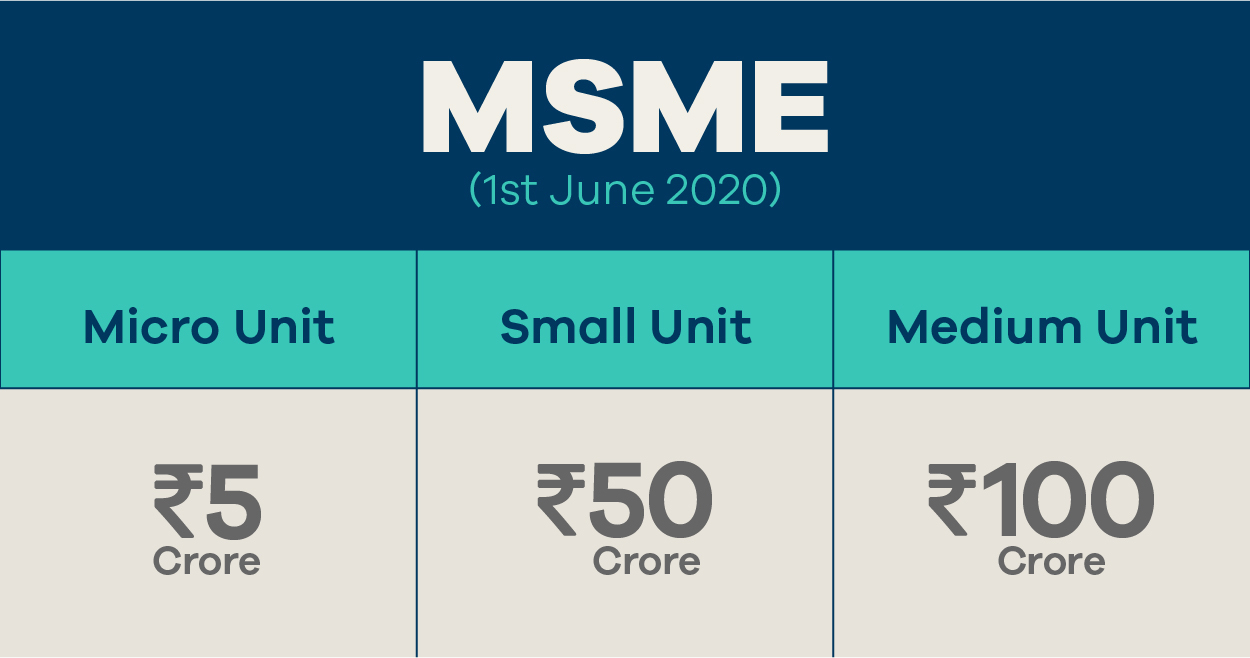
📈 MSME sector in India: Facts & Figures
MSMEs are the growth engine of India’s economy
The MSMEs play a pivotal role in the growth of the Indian economy as it employs over 114 million people and contributes more than 30% of India’s GDP.
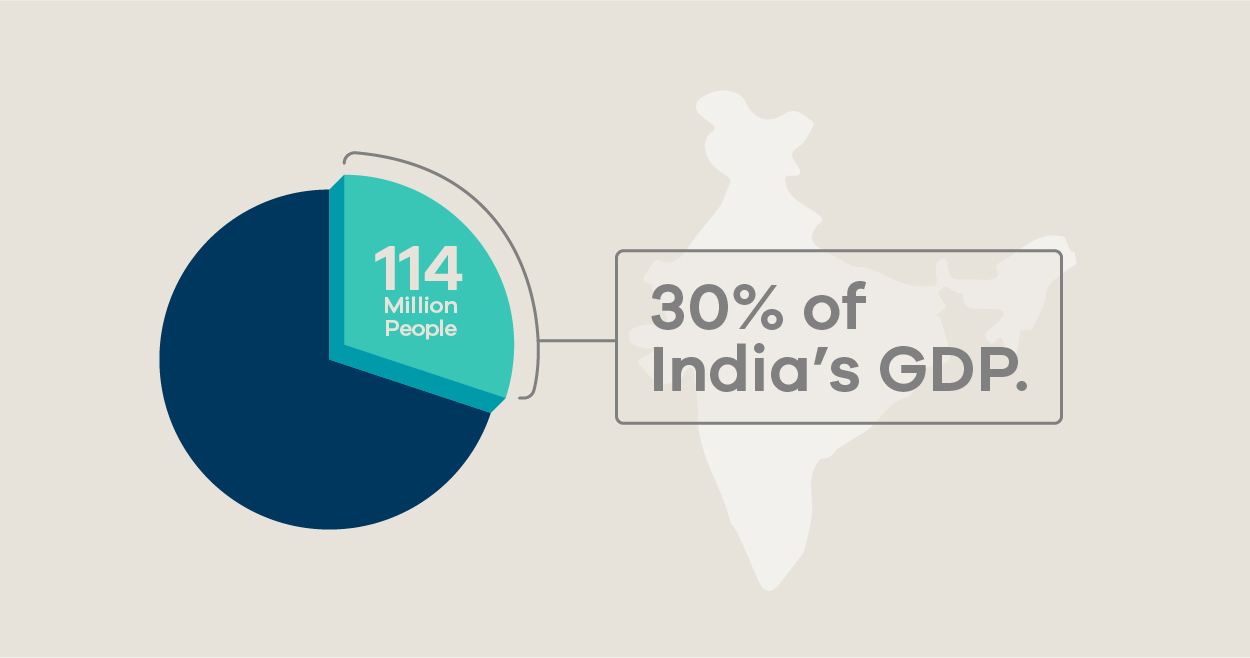
The MSME sector accounts for around 45% of the total manufacturing output and 40% of India’s total exports.
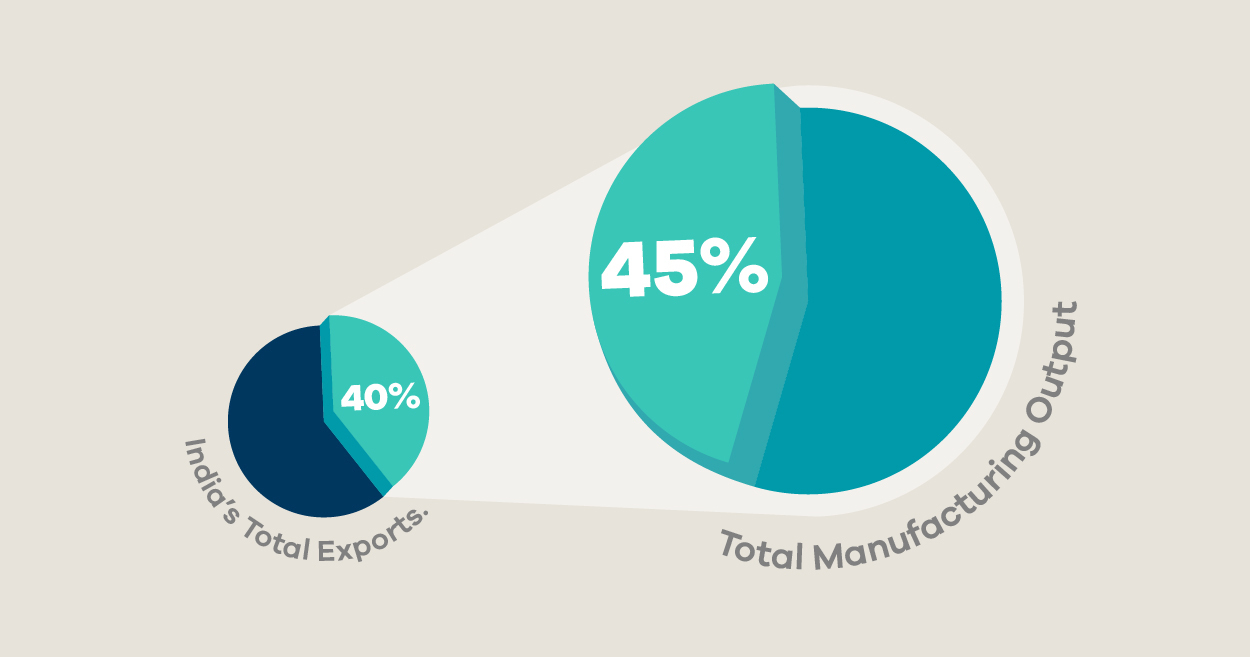
Currently, there are approx 48 million SMEs operating in India and they employ 40% of the country’s labour. After agriculture, MSMEs generate the highest rate of employment in India. In addition, the number of entrants in the SMEs sector is growing at an average of 23% in manufacturing and 31% in the services sector. The MSMEs also provide earning opportunities for people across different sections of society. It can be a great economic leveller, as nearly 50% of the MSMEs are owned by disadvantaged groups of society. MSME is truly a growth engine for the Indian economy.
Wealth + Opportunity = MSME
MSMEs play a vital role in developing the economy’s infrastructure by providing employment generation, innovation, and wealth creation. Over 6000 products ranging from traditional to high-tech items are being manufactured by the MSMEs in India.
The state of Uttar Pradesh had the largest number of estimated MSMEs with a share of 14.20% of MSMEs in the country in 2020. The top 10 states accounted for a share of 74.05% of the total estimated number of MSMEs in the country.
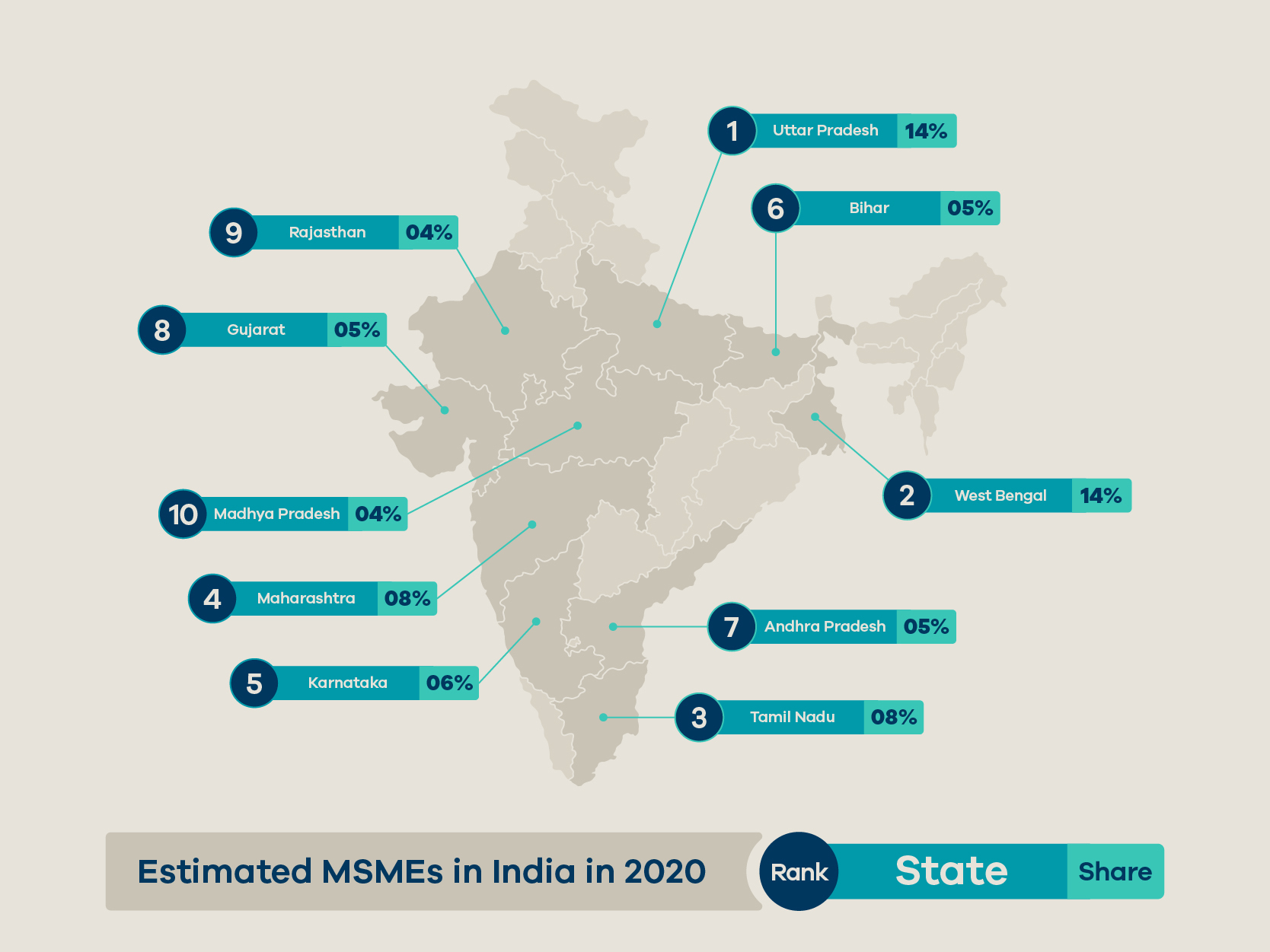
Micro-enterprises dominate the Indian MSMEs market share
According to data shared by the MSME Minister Nitin Gadkari in the Rajya Sabha, the registered MSME is dominated by micro-enterprises, followed by small and mid-sized enterprises. The total registered enterprises in 2020 stood at Rs. 22.06 lakh, 2.41 lakh, and 10.99 thousand respectively for small, medium, and large MSMEs.

Rural India comprises the lions’ share of MSMEs
Out of the 633.88 estimated number of MSMEs, 324.88 lakh MSMEs (51.25%) are in the rural area and 309 lakh MSMEs (48.75%) are based in the urban areas. The number of rural area MSMEs is expected to go up as the government is trying to promote entrepreneurship at the rural level.
The Indian government is working on creating an agro MSME category to further push entrepreneurship amidst the rural and tribal areas. This will help the manufacturing industries with generating and distributing local and raw produce. Under this category, MSME industries will be planned at a Gram Panchayat level and such industries will contribute towards the development of the respective village.
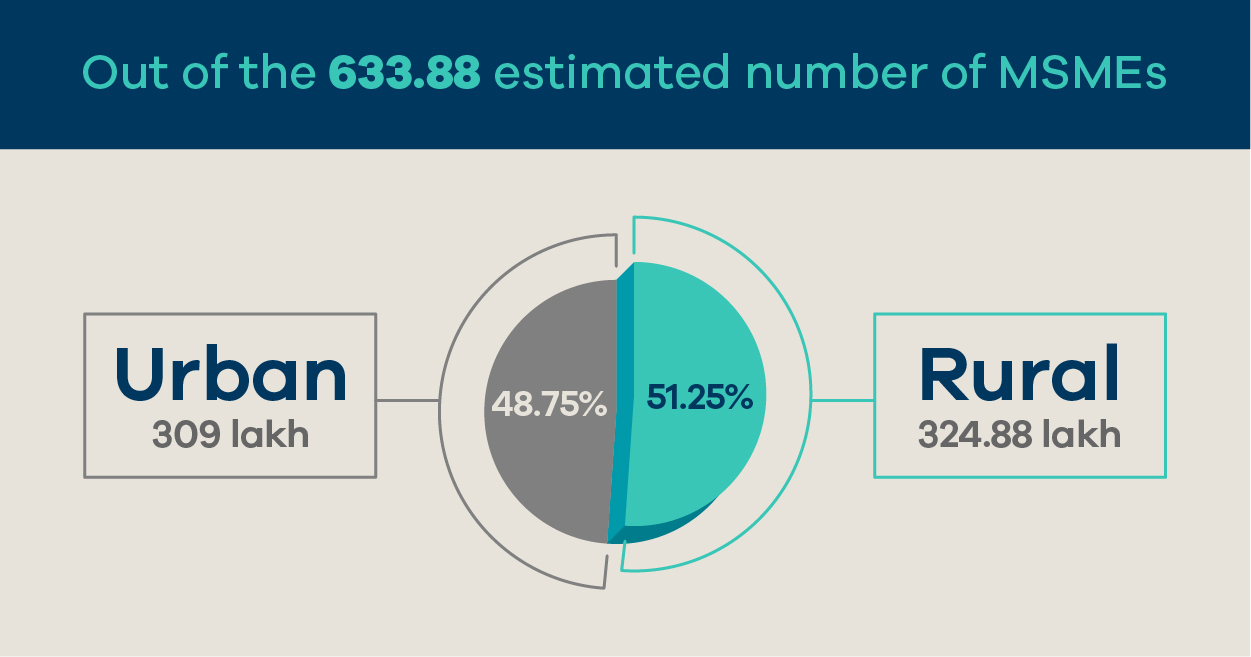
E-commerce is the way for MSMEs
A recent study by Akkeren and Cavaye states that e-commerce improves an SME’s ability to compete with larger organizations and operate on a global scale. This is a crucial time as the competition is intensifying, and customers have more options than they have ever had in the past.
The Government of India has also stepped up the game to encourage eCommerce adoption for MSMEs. The MSMEs are being encouraged to market their products on the e-commerce site, especially through Government e-Marketplace (GeM), owned and run by the Indian government, wherefrom Ministries and Public Sector Undertakings (PSU) source their procurement. The platform has recorded transactions worth INR 55,048 Crore (US$ 7.5 billion) as of September 2020.
🛒 eCommerce in India: Facts & Figures
eCommerce to boom by 2030
The $850 billion Indian retail market is the fourth largest in the world and the Indian eCommerce sector is projected to grow to US$ 300 billion by 2030.
This is already changing the way small and medium businesses operate in India. What’s more promising is the growth in the number of internet users in India. Currently ranked at number 2, worldwide, with the highest internet users ~ 560 million, this number is expected to rise to 1 billion by 2025. This predicted growth of internet users provides an amazing opportunity for Indian MSMEs to become digital-ready.
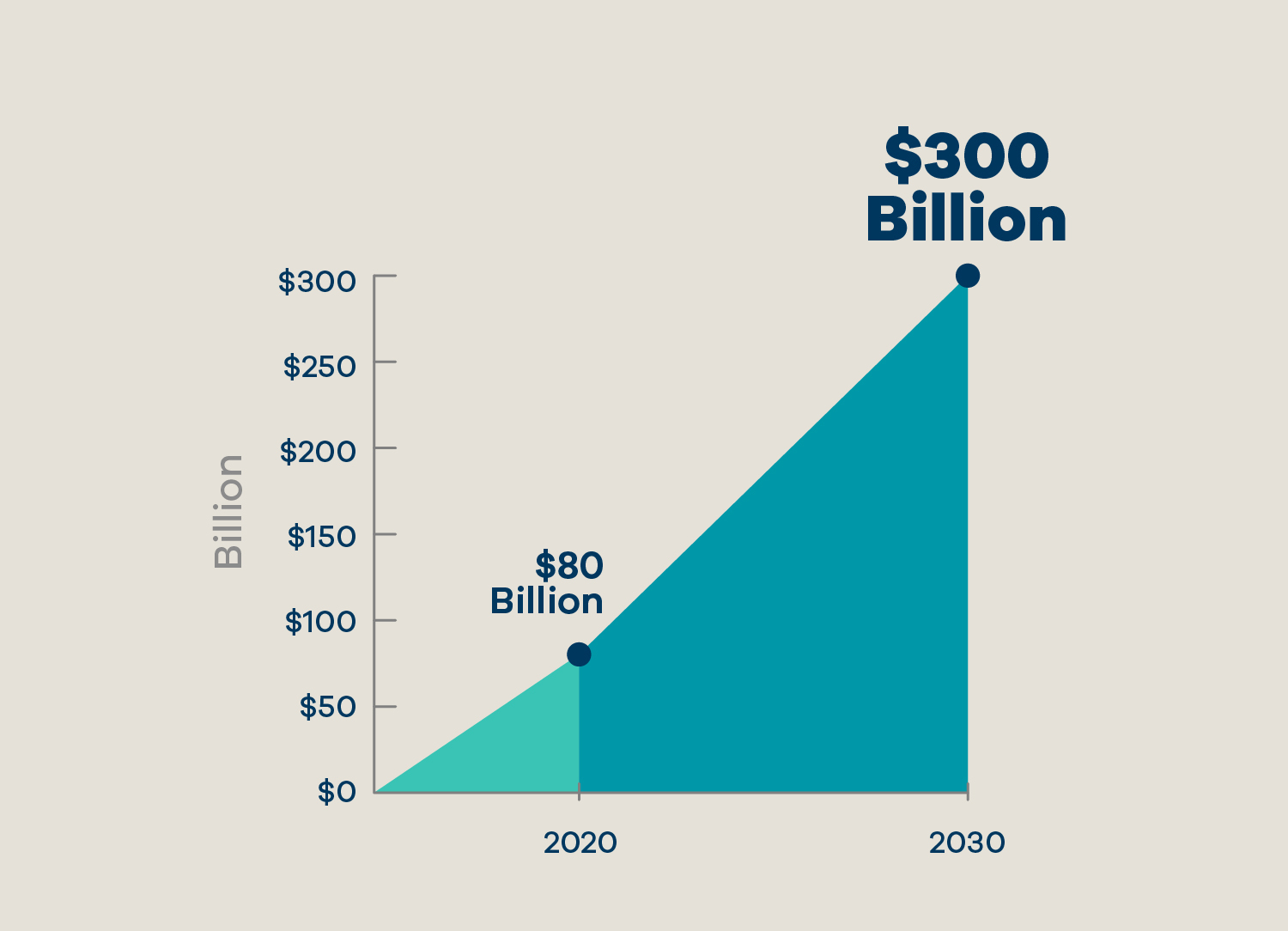

Only 43% of MSMEs participate in the eCommerce space
MSMEs in India may or may not have an online presence, but 43% of them participate in online sales. By adopting eCommerce, MSMEs can gain significant advantages such as:
- improved market reach
- access to new markets
- cost savings in marketing and customer acquisition
- improved customer experience
- increased revenues and margins
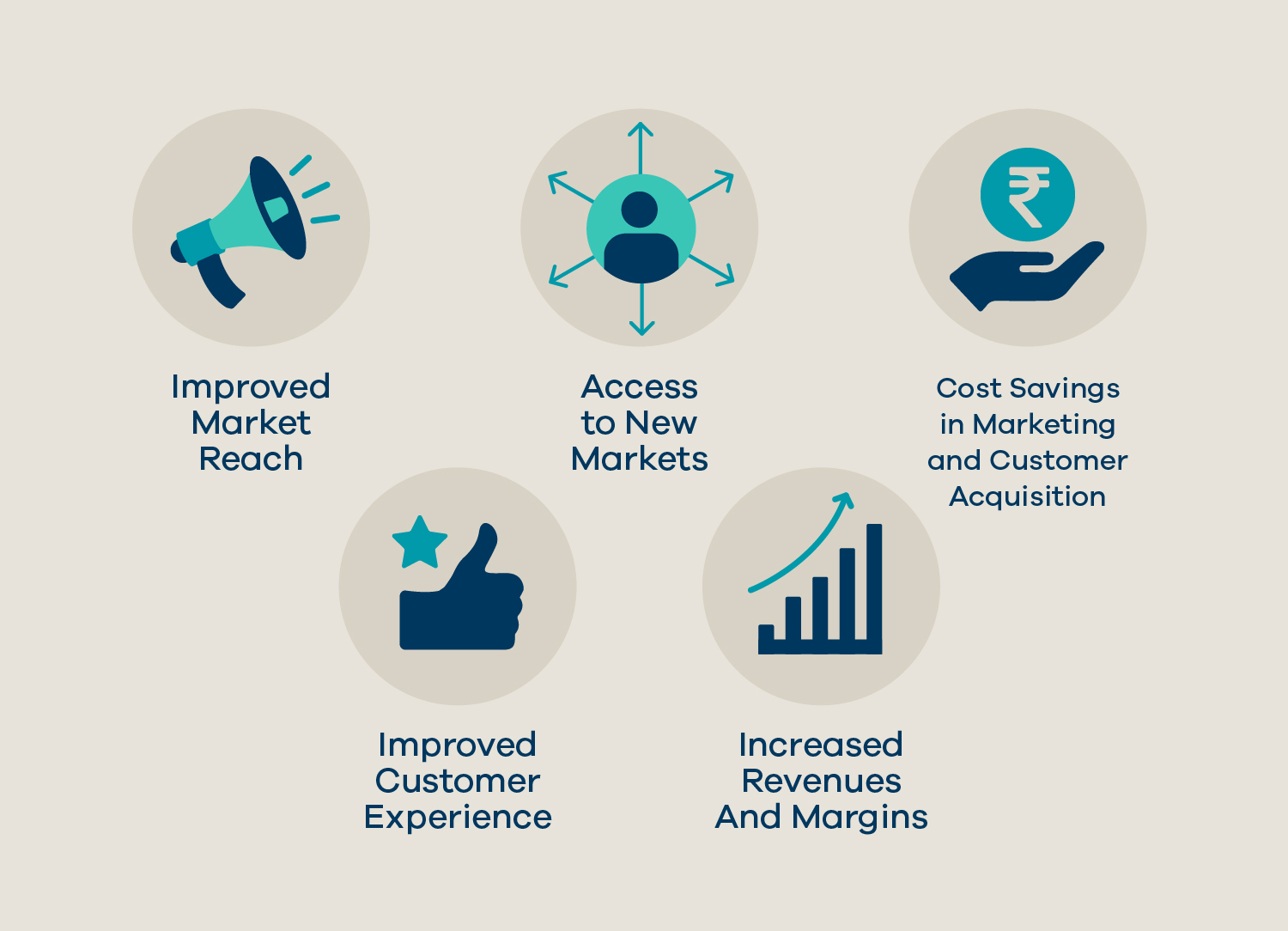
Other advantages of adopting an eCommerce approach by small and medium-sized enterprises are that it levels the playing field with the big businesses, by providing location and time independence, ease of communication, and the ability to achieve competitive advantages for their business.
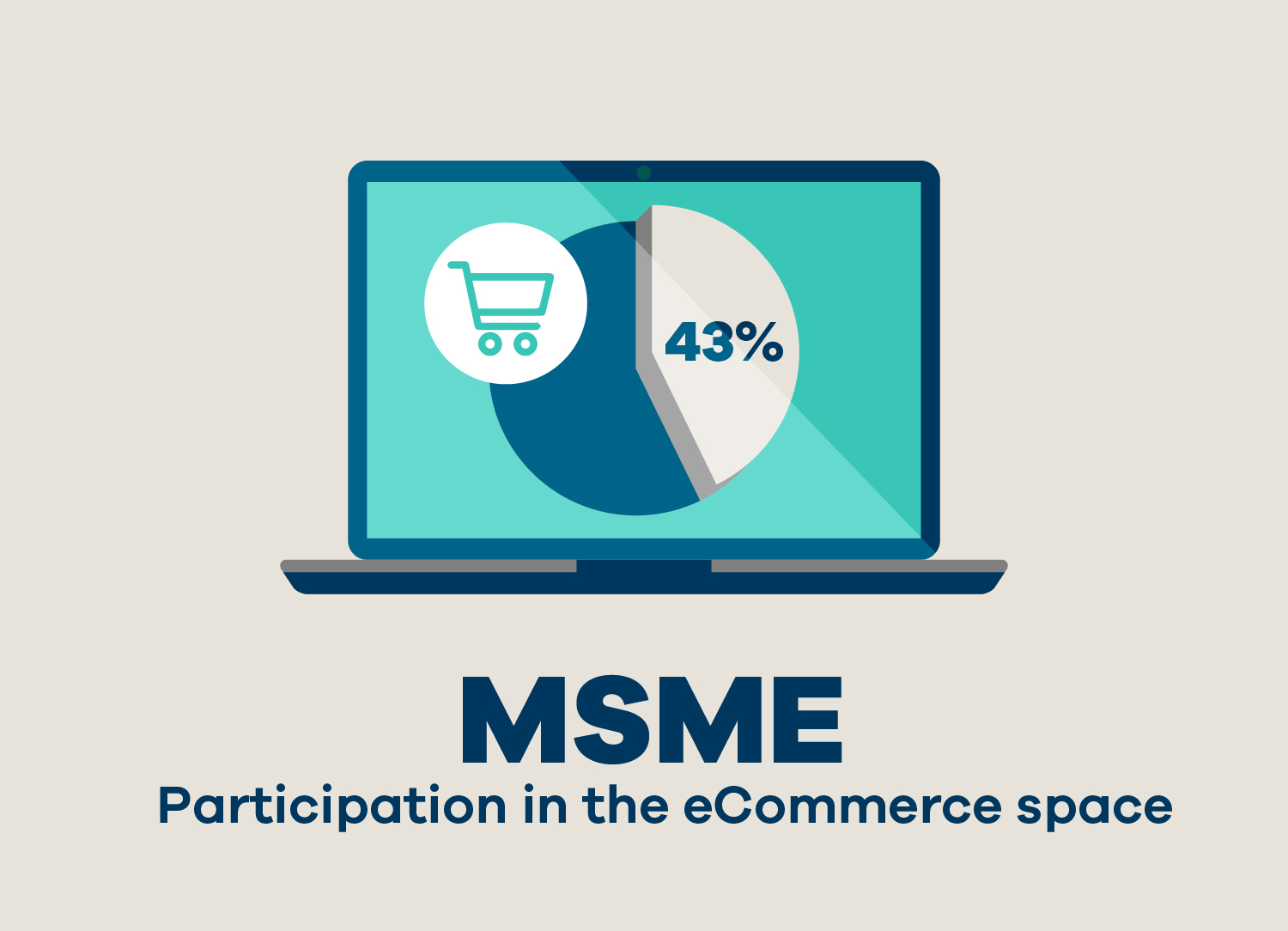
Decreased costs, and increased sales; the eCommerce way!
The MSMEs that are selling online are of the view that eCommerce has significantly reduced costs of marketing and has improved business prospects. Web-enabled SMEs have higher profits, have a wider customer reach, and improved employment opportunities. SMEs’ using eCommerce recorded a 60%- 80% decrease in marketing and distribution costs. 69% of SMEs reported an increase in the number of customers due to the accessibility to the internet.
As per a survey conducted by KPMG India, 56% of SMEs believed that the use of the internet is critical for business growth while 22% are completely ignorant about the potential of being available on the internet platform for their business.
Potential benefits of eCommerce to Indian SMEs
- up to 51% higher revenues via sales
- 60-80% cost reduction in sales and marketing efforts
- up to 49% more profit due to a decrease in overhead costs
- up to 7% wider customer reach
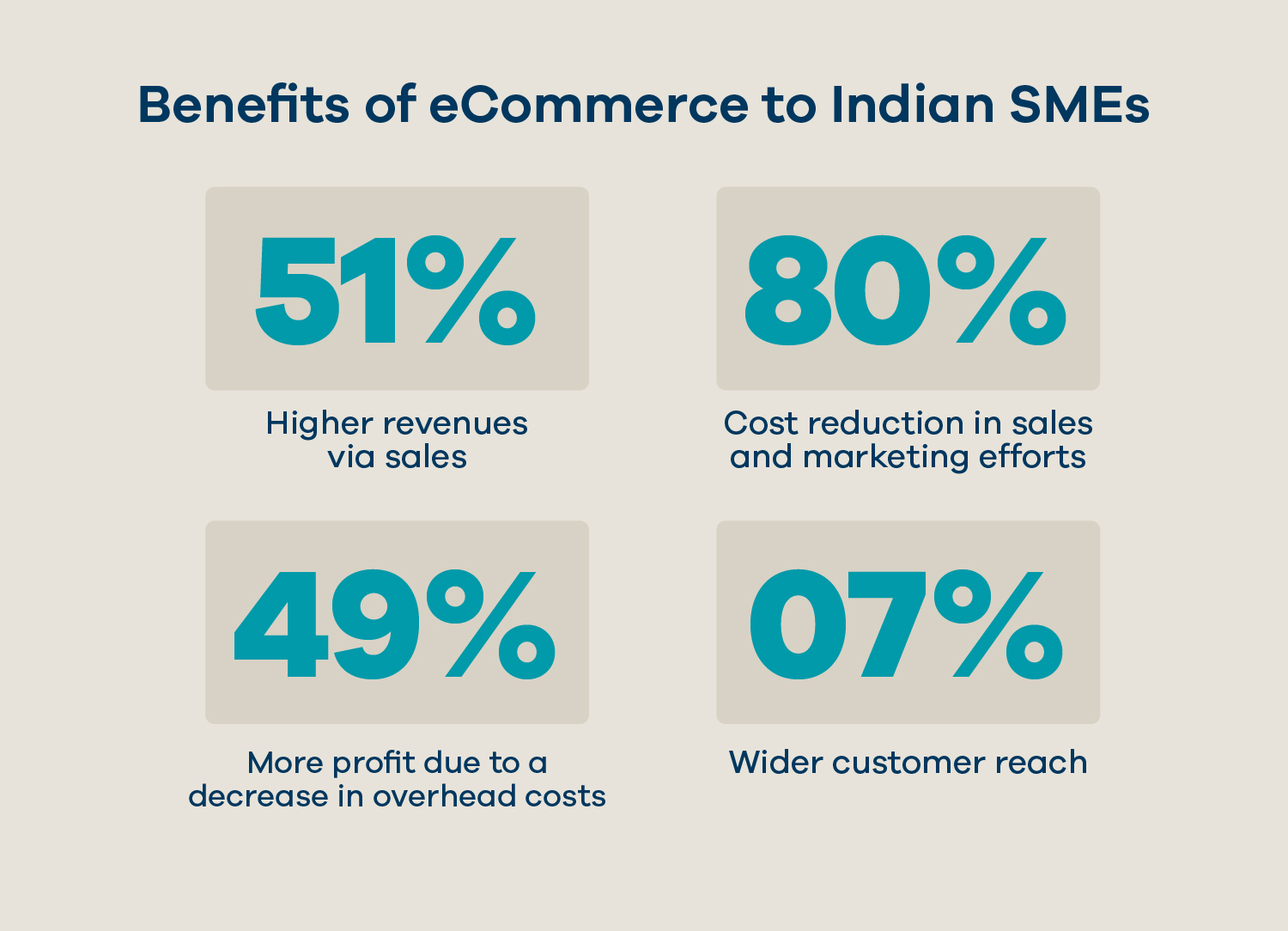
Today, 20% of the online seller base comprises women entrepreneurs due to factors like low setup costs of business, audience reach, work-life balance, and better margins when compared to offline sales.
In order to augment sales and growth, and for capturing the market, the most widely adopted promotion tool by MSME owners is advertising (31.30%). Whereas discount sales are preferred by (26.08%), personal selling & pamphlets constitute (21.73% & 20.86%).
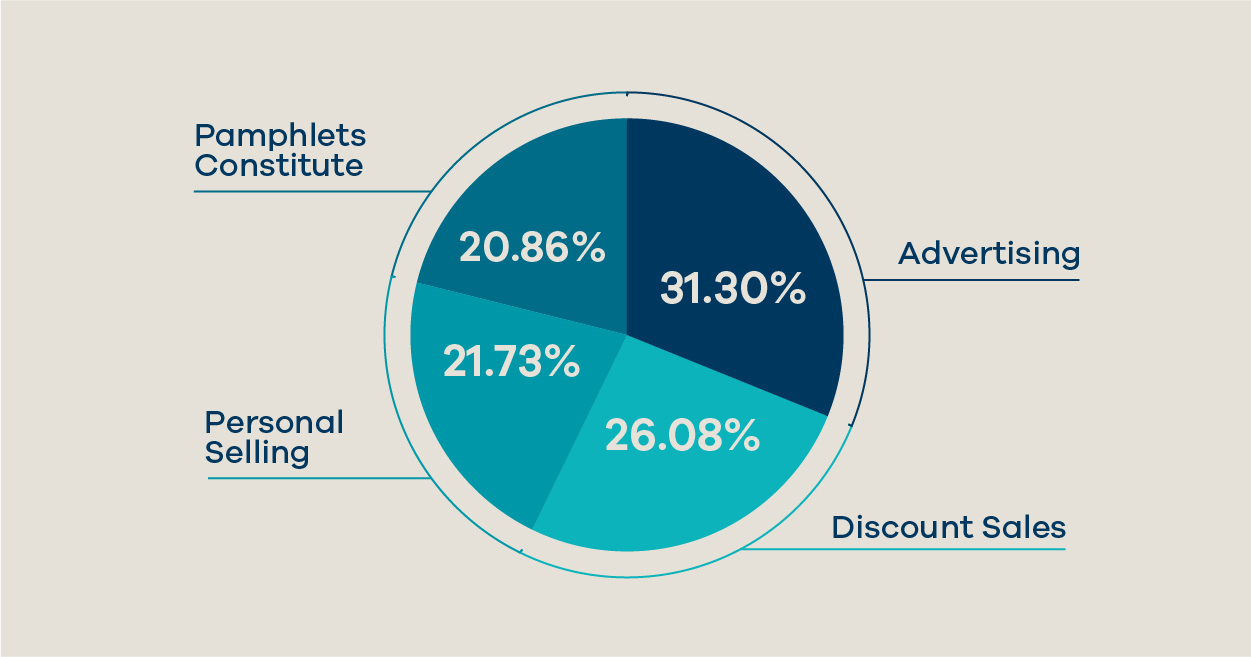
The point to be noted is that the MSME owners in India rely on more than one channel of promotion at any given point in time.
Increased number of internet users- a booming eCommerce
Increasing the internet’s reach, along with smartphone and social media usage has driven the growth of eCommerce in India. The internet reach in India went up to nearly 45% in 2021, from just about 4% in 2007.
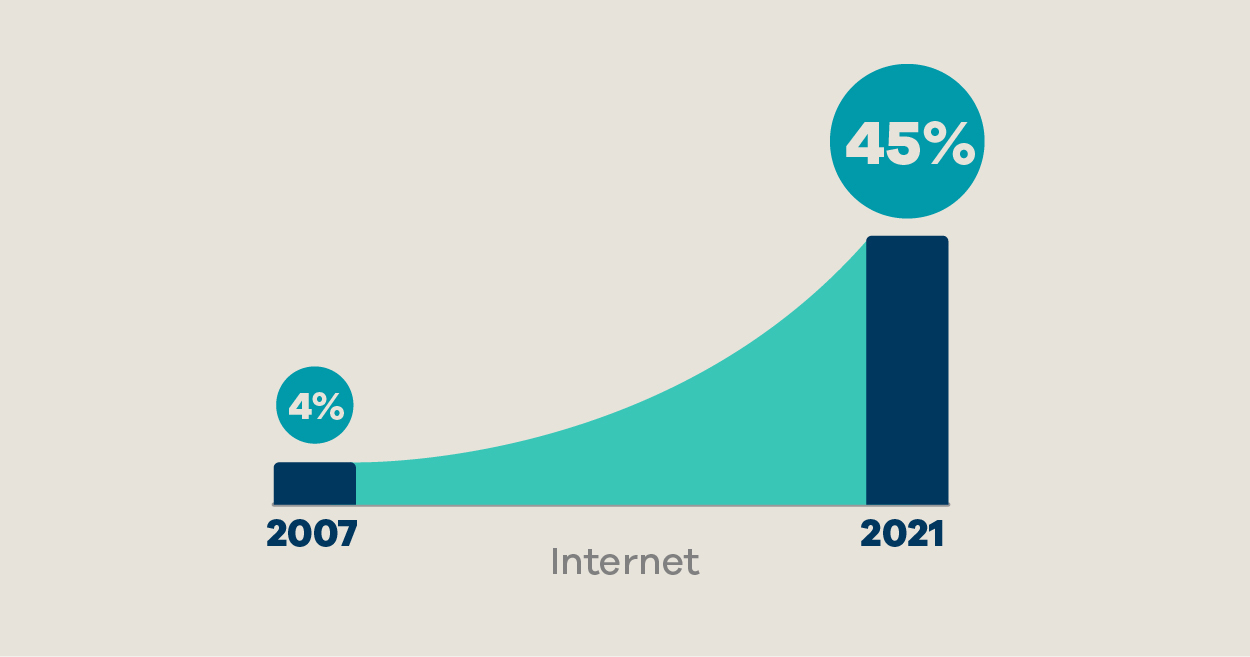
Exorbitant real estate prices, high operational costs, and a lack of appropriate retail spaces have restricted the expansion of larger physical stores, forcing big retailers to turn to eCommerce platforms as a growth avenue. In addition to their websites and existing physical stores, the larger retailers have also benefited from adopting eCommerce to sell merchandise. In a study across Tier I and Tier II Indian cities to understand consumer behavior and purchasing, 17 patterns emerged, and 53.3% of respondents stated that they preferred online shopping.
Lack of awareness is hurting the MSMEs
Currently, there are over 12 million operational kiranas across the country. Even kirana stores were impacted by the lockdown; over 600,000 are estimated to have shut down in the first two months of the lockdown in 2020. To prevent such vulnerabilities, small retailers must digitize their sales and business operations. In a 2020 survey, in midst of the lockdown, 40% of Kirana stores polled indicated a willingness to partner with online delivery and supply platforms to help them keep the business running and growing.
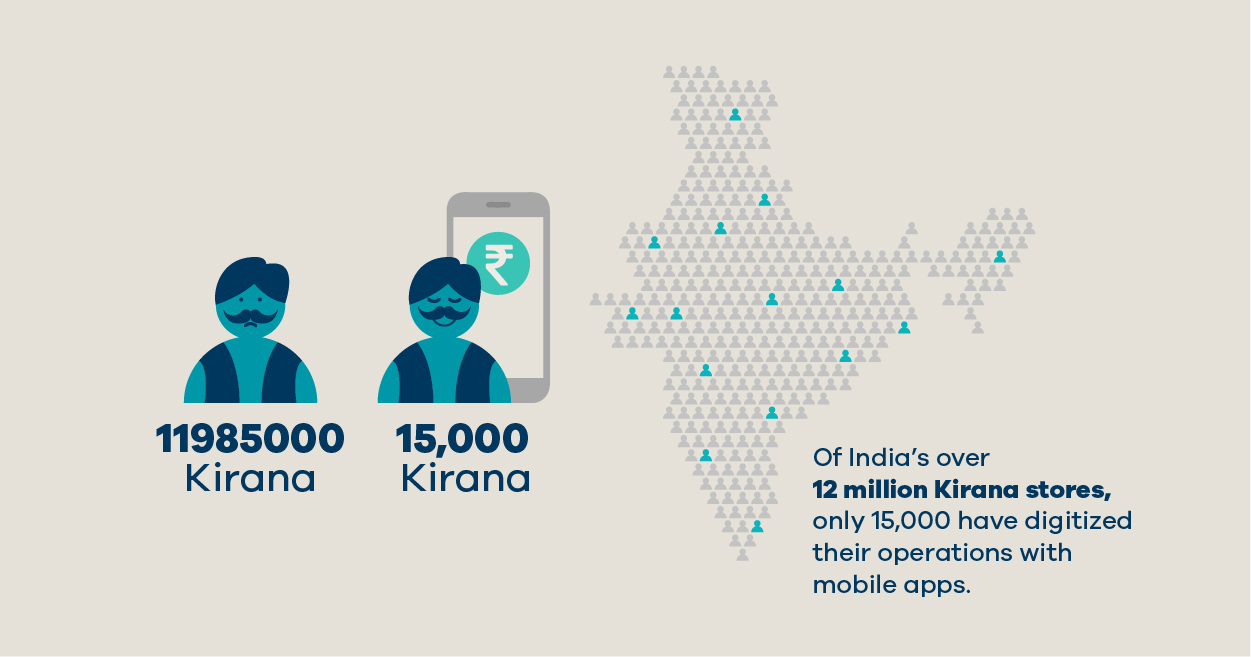
However, the Kirana store proprietors appear hesitant to adopt digital solutions. Of India’s over 12 million Kirana stores, only 15,000 have digitized their operations with mobile apps. A study found out the reasons for not adopting internet marketing and eCommerce was lack of awareness (40%) as the most significant problem, followed by the perception that e-marketing tools are not required (31.30%) to spread the word. Lack of skill and experience (28.69%) was also accounted as a hurdle in the adoption of these marketing channels.
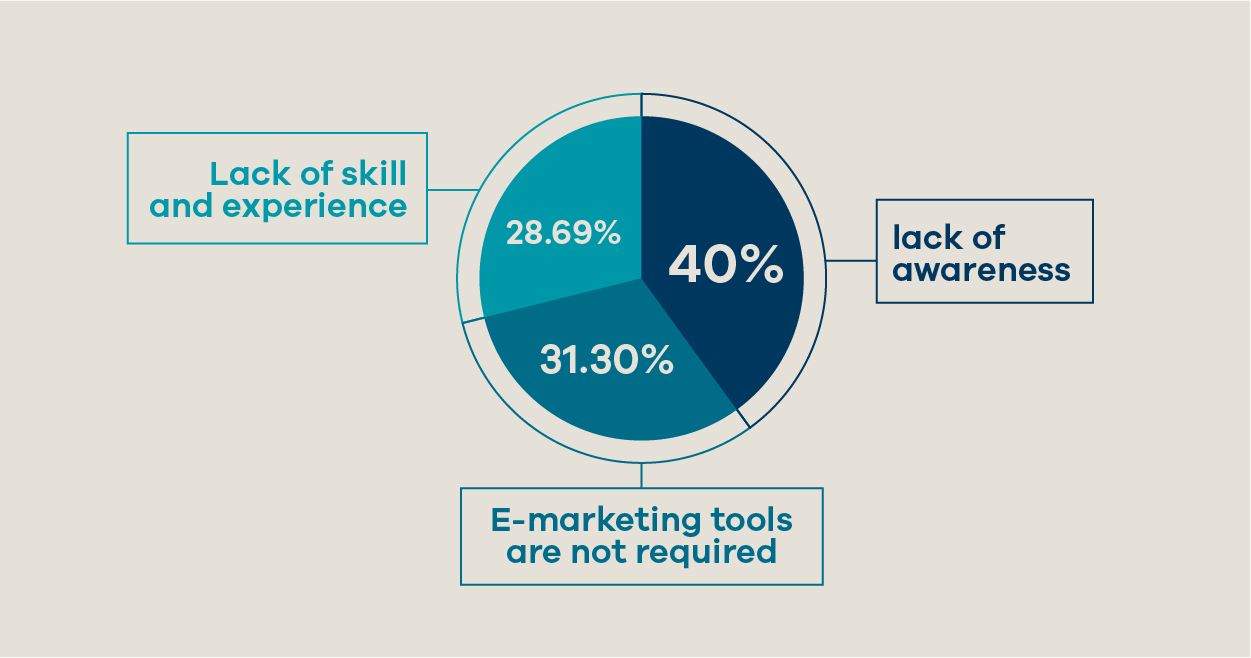
eCommerce has already made its way to more than 95% of pin codes
E-retail has already democratized the shopping landscape, with access to more than 95% of India’s pin-codes, and empowering India’s small sellers while breaking go-to-market barriers for insurgent and incumbent brands.
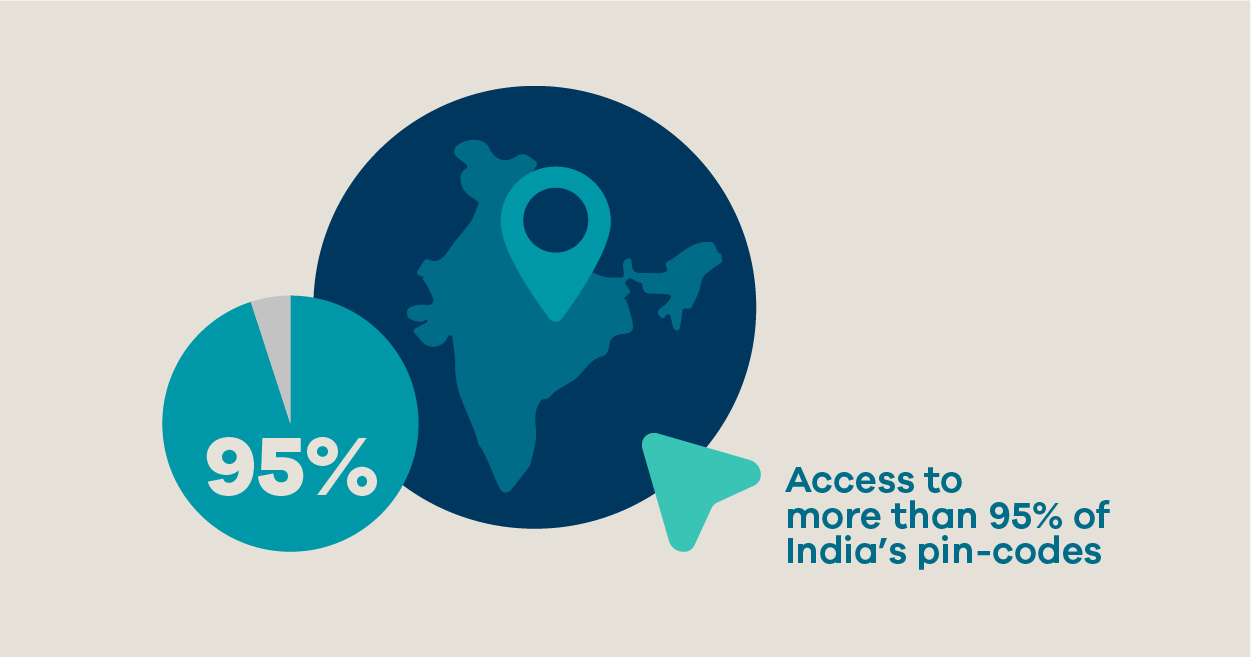
A microcosm of the pan-Indian retail market, the online shopping landscape comprises a diverse mix of city tiers and income ranges. Online shoppers in tier-2 and smaller towns make up nearly half of all shoppers and contribute to three out of five orders for leading e-retail platforms. These customers from tier-2 and smaller towns buy similar categories of products as customers from metro cities or tier-1 towns with only a marginal difference in average selling price.
How do Indians shop online?
A recent report by Bain and Flipkart pointed out interesting insights:
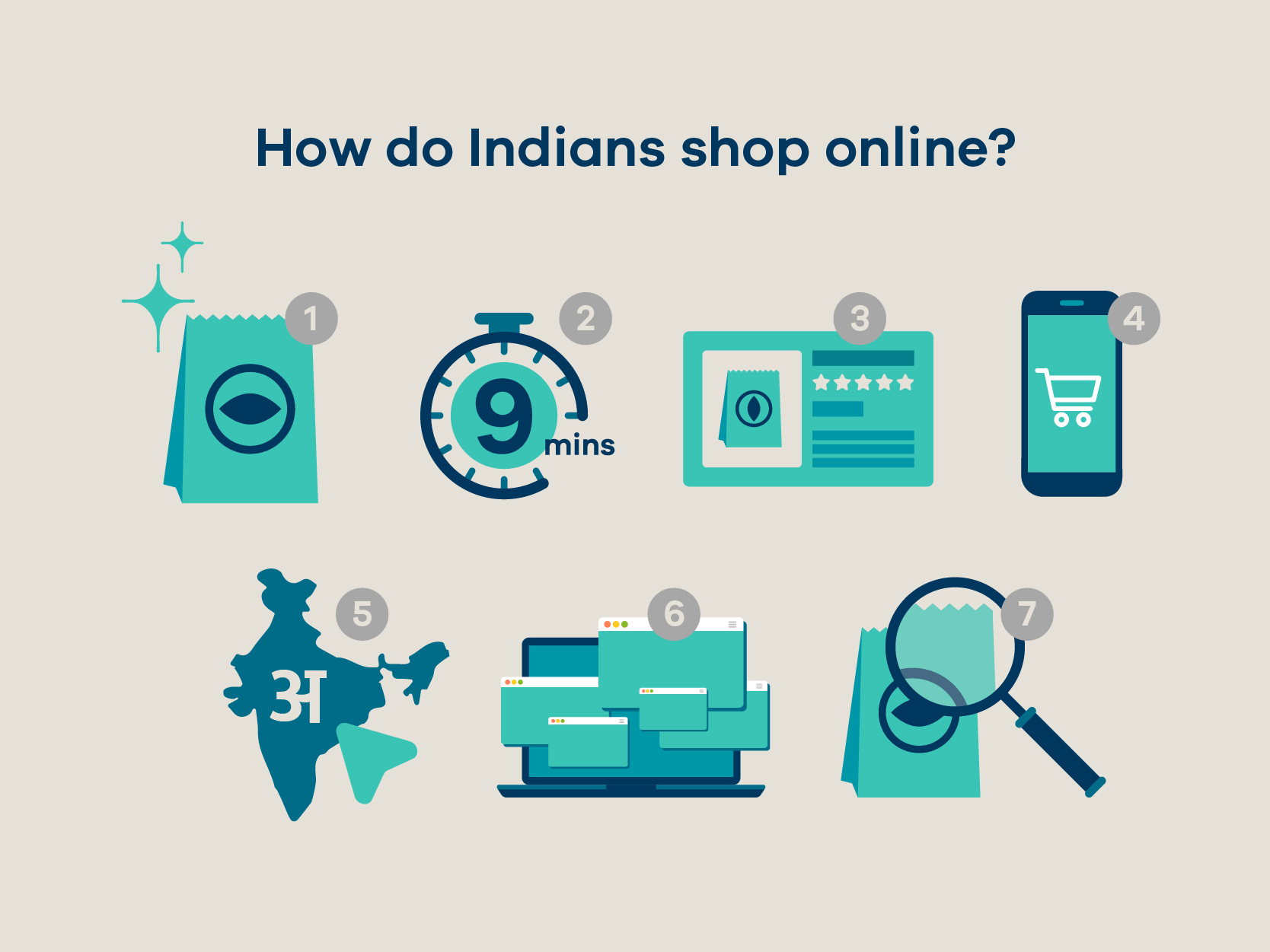
- As people have plenty of options to choose from, they are short on time. In order to succeed, you have to deliver what they are looking for by using high-quality images, vernacular content, and easy product discovery
- Nine minutes is all you have: over the past year, consumer engagement with online platforms has increased but a visitor spends less than nine minutes per visit on an e-retail platform
- Pictures speak more than words: one in two visitors browse the image gallery and only 1 in 15 clicks the detailed product description. Brands and sellers should invest in images, videos, and pithy but high-impact product highlights
- Product discovery on e-retail platforms: consumers are increasingly opting for e-retail platforms for product searches; one in three in India, and two in three in the US
- Vernacular searches are gaining popularity: as an example, ‘Parda’ was one of the top three searches for curtains
- Browse, browse, browse: online shoppers browse more than 20 product pages before making a purchase, some categories like mobiles and women’s ethnic wear, have consumers browse about 50–60 product pages before making a purchase
- Different horses, different courses: search attributes and preferences vary significantly across categories and consumers. Online shopping data provides interesting insights into specific product preferences of Indian shoppers at a granular level.
📉 Covid-19 and challenges for MSMEs
The nationwide lockdown not only halted the production and led to sluggish demand, but several fixed (uncontrollable) costs increased the expense side of the enterprises when the revenue side was at a standstill. The sector is informal, unstructured, underfinanced, and prone to threats like cyclical shocks, lack of demand, untimely payments.
The efficiency of global markets is further putting these enterprises under the threat of an existential crisis. New challenges like a halt in production, unavailability of labor/manpower, falling consumption, lack of liquidity, rising fixed costs will further magnify the problems faced by the MSMEs.
As per the survey conducted by AIMO (All India Manufacturers Organisation) in June 2020, 35% of MSMEs’ and 43% of the self-employed people expressed that it was difficult for them to recover their business back to its original position, and they have decided to shut down their business operations. Their earnings were impacted by 20%-50% more than before during this COVID-19 lockdown. As a consequence of this, thousands of people were left unemployed which made the hit to the economy much worse.
In the light of the rising concerns of a struggling economy, the Government of India had announced certain measures for the revival of the economy. On 12th May 2020, Prime Minister Narendra Modi announced the ‘Aatma Nirbhar Bharat Abhiyaan’ or ‘Self-Reliant India Mission’ economic package.
The first trench of the Aatma Nirbhar Bharat Abhiyaan was announced as an INR 20 lakh Crore economic package (which constituted approx. 10% of the total GDP). The Atmanirbhar Abhiyan talks about the 5 pillars of self-reliant India and MSMEs’ have a major role in strengthening all the five pillars namely – economy, infrastructure, technology-driven system, vibrant demography, and demand. Standing next to agriculture in terms of employment generation, a huge potential lies in the MSME sector.
🔮 What future holds for the Indian MSMEs?
Fashion and Grocery sectors will drive growth
India’s domestic e-commerce market is expected to reach US$ 99 billion (approximately INR 7 lakh Crore) by 2024, increasing at a compound annual growth rate (CAGR) of 27% during 2019-2024, and will reach INR 13,97,800 Crore (US$ 200 billion) by 2027. The grocery and fashion/apparel sectors are poised to drive this growth, triggered by expanding internet and smartphone usage.
1 billion internet users by 2025
India is the second-largest smartphone market, accounting for nearly 10% of global smartphone sales, and the number of domestic smartphone users is expected to rise to approximately 450 million by 2021– 22, from 260 million in 2016–17.
Internet usage in India grew to nearly 45% in 2021, from a mere 4% in 2007. The number of internet users is expected to rise further to ~ 1 Billion by 2025, from 445.96 million in 2017.
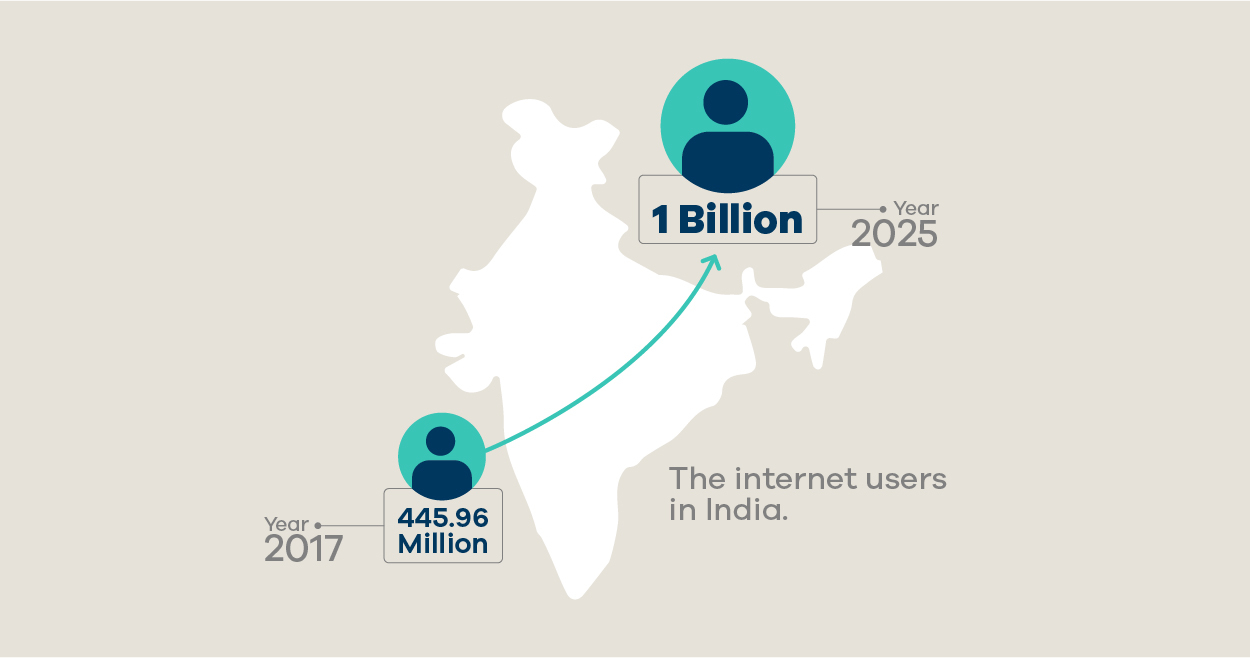
Internet usage in rural India is projected to grow by 45% by 2021, up from almost 22% as logged in 2019.
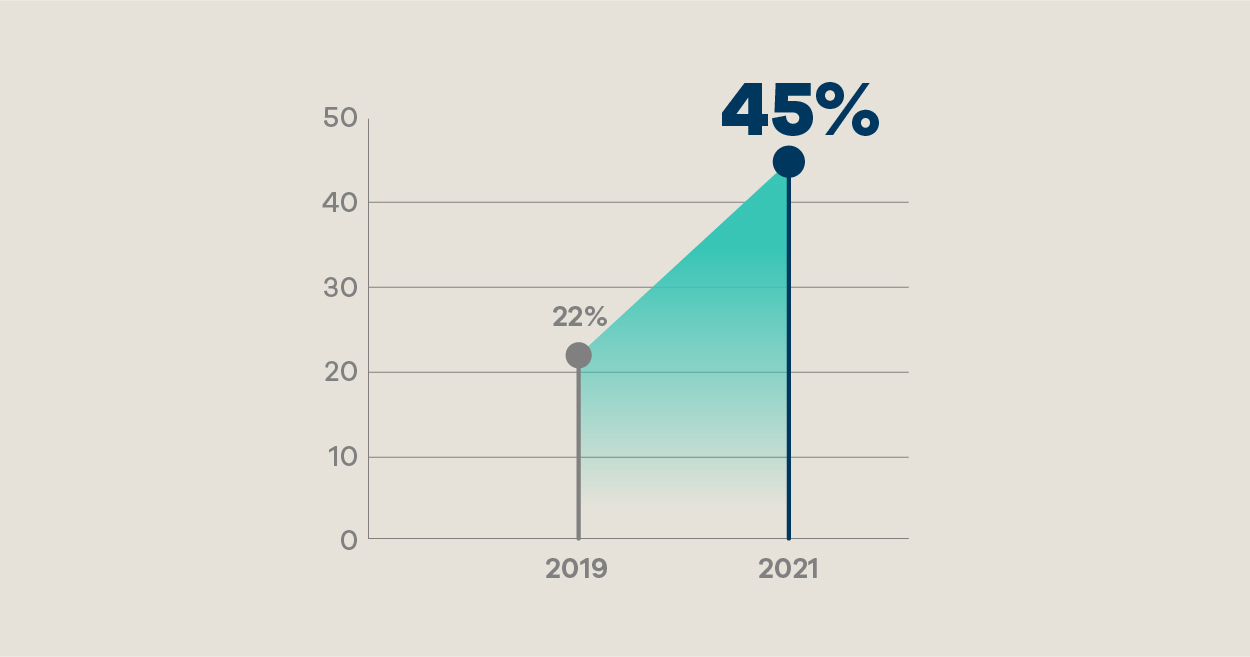
Online shopping to reach 220 million shoppers by 2025
Online shoppers in India are expected to reach 220 million by 2025, from 120 million in 2018. The evolution from ‘bricks vs. clicks’ to ‘bricks and clicks’, or ‘offline complements online’, will pave the way for an intermix retail mode- traditional stores, modern brick-and-mortar stores, and online channels, complementing each other.
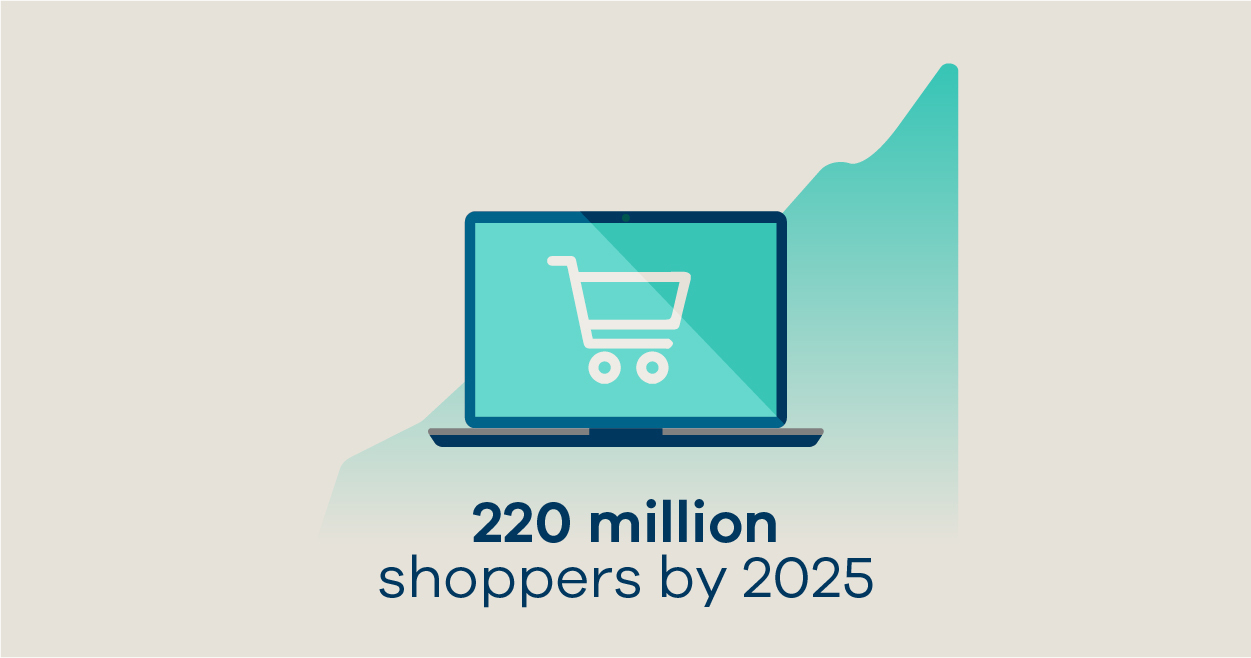
Developing such symbiotic partnerships will enable the growth of small stores, including kiranas. The Indian e-retail market is primed to reach a Gross Merchandise Value (GMV) of $100-120 billion by 2025.
Visual and Vernacular is the future of eCommerce
To encourage small stores, especially kiranas, to digitize, the government, regulators, and private players must work to build trust in and increase the perceived usefulness and ease of use of digital technologies for conducting business.
Alongside, digital service providers must improve their user interface, and make apps available in vernacular languages, which in turn will enhance the ease of use leading to the adoption of digitization by these businesses.
Multiple combinations of using digital media were evaluated. 4 of the most popular combinations’ identified were:
- Voice and vernacular: The Indian vernacular-language internet user base, which is expected to reach more than 500 million users by 2021 (vs. 200 million English-speaking internet user base in India), increasingly prefer voice search and vernacular-based User Interfaces (UIs).
- Visual and video: Video content consumption in tier-2 and smaller towns in India grew more than four times in the last year (2020). Visual search tools, live-streaming sessions, influencer videos, etc. are gaining significant traction.
- Social shopping: For the next wave of online customers, peers and community play a much larger role in influencing purchase decisions than for the current online shopping base. Apps that allow friends and families to shop simultaneously will serve to boost sales.
- Digital ecosystems: As e-retail evolves, the retail platforms are trying to increase their number of consumer touchpoints to gain greater customer mindshare. Top e-retail companies have started to develop ecosystems that combine their core e-retail business with sticky customer services such as video streaming, gaming, booking, and payments in a single platform or application.
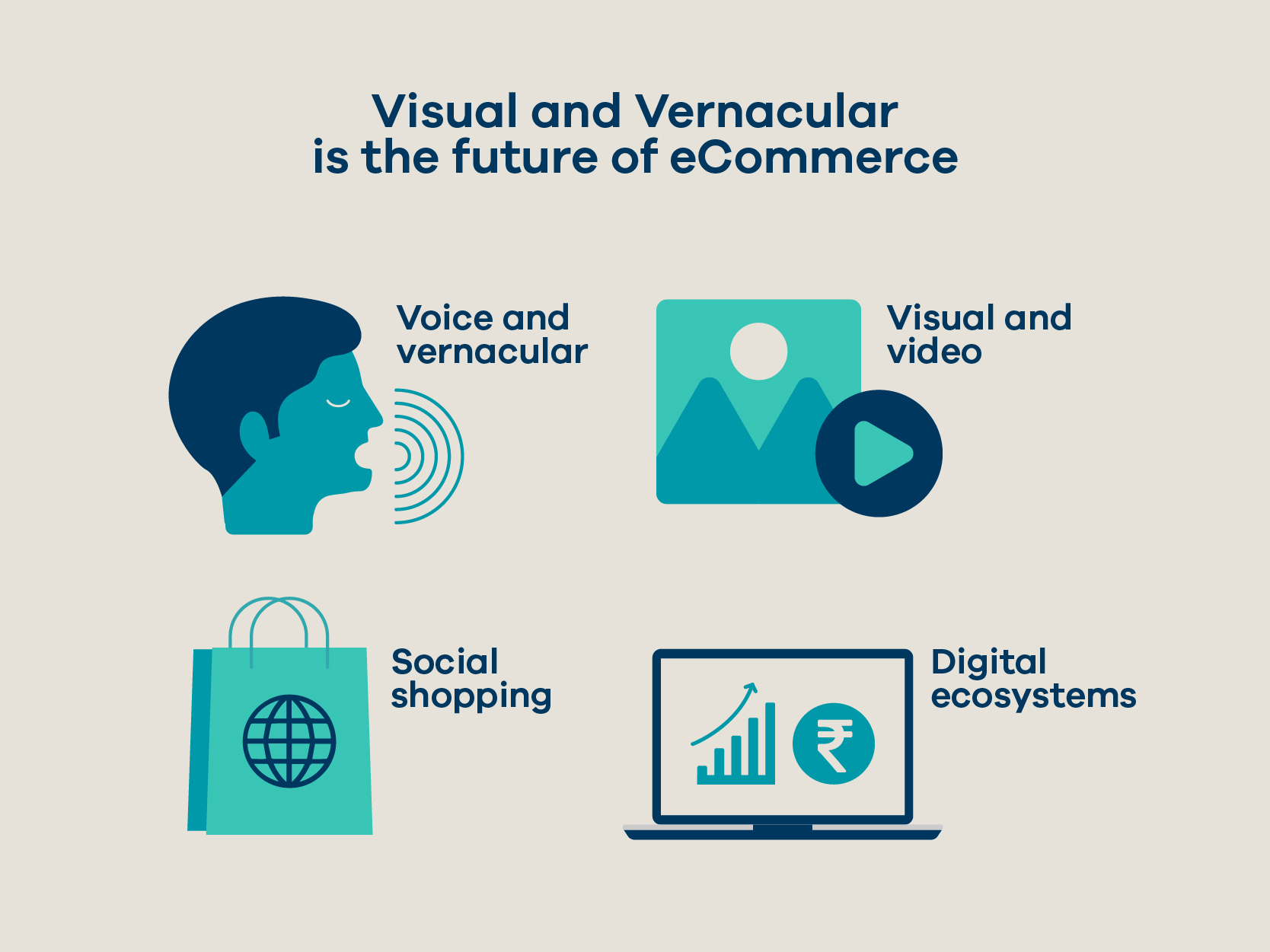
7 key levers for MSMEs to succeed
The online shopper landscape is rapidly changing with an increasing share of tier-2 and smaller town consumers. Digital shopping has scaled up from the experimentation phase to implementation and is ever-expanding its presence. 7 key levers for MSME success were identified. Brands should evaluate their readiness across seven key levers to win online:
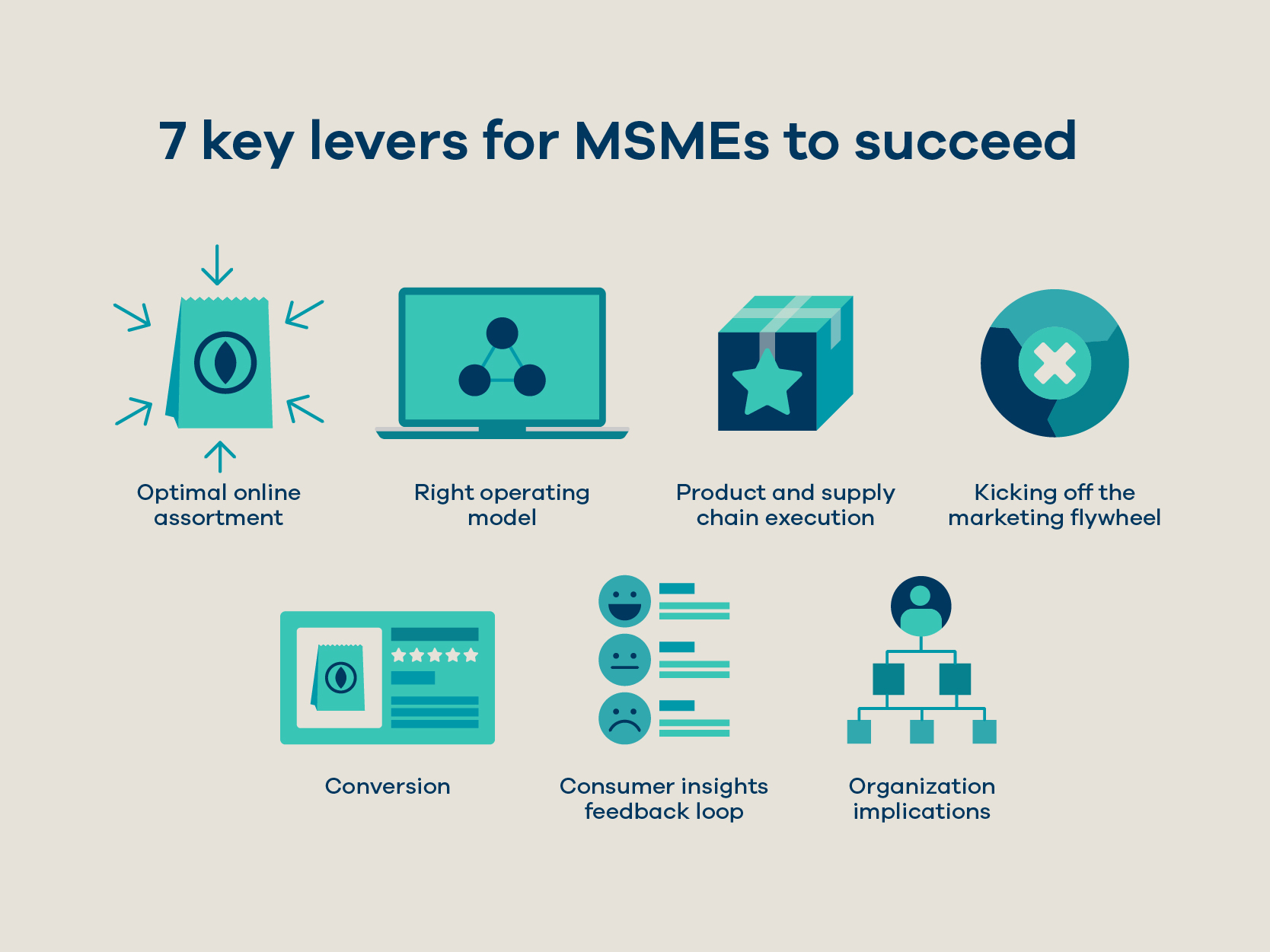
1) Optimal online assortment
- Range-width depending on category dynamics
- Modified pack sizes and combos for the online buyer
2) Right operating model
- Complimentary assortment across channels/sellers
- Synergistic roles of channels (marketplace, own site)
3) Product and supply chain execution
- Highly rated products- superior/premium quality
- Supply chain: fill rate, promised vs. actual delivery timelines
- Visually appealing, discreet packaging
- Low returns relative to the category
4) Kicking off the marketing flywheel
- Marketing mix optimization and content hyper-personalisation (including usage of vernacular language)
- Inorganic/paid visibility
- Organic visibility-content, search engine optimization (SEO), conversion
- Role of influencers and digital-specific advertisements in improving engagement
5) Conversion
- Descriptive product display pages with the right mix of images, videos, and pithy product summaries
- Competitive pricing
6) Consumer insights feedback loop
- Leverage e-retail’s granular consumer data and ability to do rapid prototyping, A/B testing, etc. to accelerate new product launches/improvements, improve targeting, and go-to-market efficiencies
7) Organization implications
- Coordination across digital merchandising, content, supply chain, DTC, technology, aligned capabilities, budgets, and incentives
- Agile cross-functional teams trained in winning in digital marketing and selling
Summary
Small and Medium enterprises are said to be the backbone of India’s economy and we cannot imagine a more interesting time for these enterprises to grow and build their market presence. The future is full of possibilities for MSMEs and is up for grabs because of the virtue of a booming eCommerce space in India.
eCommerce has proven to be a catalyst to change the growth trajectory of Indian enterprises, but government and industry players have to bridge that digital divide- which inhibits the growth of online commerce for the MSMEs. Adoption of the above-listed strategies and setting up robust digital operational parameters will be conducive to converting the MSMEs into the major players of the Indian eCommerce market.


Leave a Reply
You must be logged in to post a comment.